INDIAN ARMED FORCES CHIEFS ON OUR RELENTLESS AND FOCUSED PUBLISHING EFFORTS

The insightful articles, inspiring narrations and analytical perspectives presented by the Editorial Team, establish an alluring connect with the reader. My compliments and best wishes to SP Guide Publications.

"Over the past 60 years, the growth of SP Guide Publications has mirrored the rising stature of Indian Navy. Its well-researched and informative magazines on Defence and Aerospace sector have served to shape an educated opinion of our military personnel, policy makers and the public alike. I wish SP's Publication team continued success, fair winds and following seas in all future endeavour!"

Since, its inception in 1964, SP Guide Publications has consistently demonstrated commitment to high-quality journalism in the aerospace and defence sectors, earning a well-deserved reputation as Asia's largest media house in this domain. I wish SP Guide Publications continued success in its pursuit of excellence.
India-Russia relations take next step
 |
By Lt. General P.C. Katoch (Retd) Former Director General of Information Systems, Indian Army |
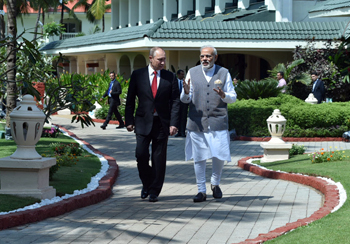
Russian Federation,Vladimir Putin moving for media
statement and MoU exchanges, in Goa on October 15, 2016
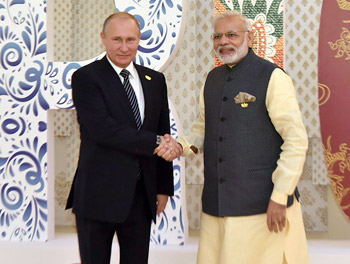
BRICS Summit
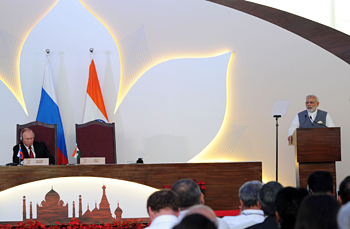
October 15, 2016, Vladimir Putin is also seen
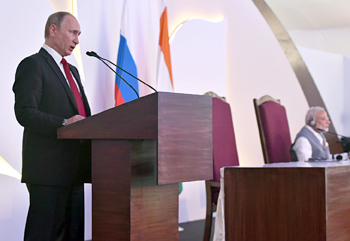
October 15, 2016,Narendra Modi is also seen
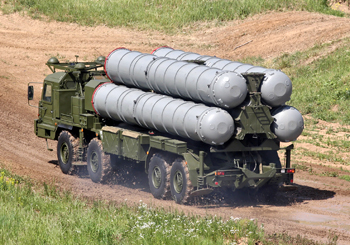
The recent meet between Prime Minister Narendra Modi and President Putin of Russia on the sidelines of the BRICs summit at Goa and the deals signed between India and Russia have silenced the critics that the Modi Government is putting all its eggs in the basket of America. It also takes out the gas from the hype in Pakistani media that Russia has moved away from India and is now closer friend of Pakistan, a Russian-Pakistani defence pact is in the offing and a China-Russia-Pakistan axis is becoming a reality.
Modi had wide ranging talks with Putin covering the entire gamut of bilateral engagement. 16 agreements were signed between the two countries that included: deal worth $5 billion plus for S-400 Triumph air defence systems from Russia, which was being discussed between the two countries for over a year; establishment of $1 billion 'Russian Indian Investment Fund that would include $500 million push into infrastructure in India and space alongwith an equal investment by the newly formed National Infrastructure Investment Fund (NIIF); joint venture to build at least 200 Kamov helicopters in India; joint agreement on shipbuilding and specialist training in Andhra Pradesh: dedicating Unit 2 of Kudankulum nuclear power plant and foundation laying of Units 3 and 4; agreement on 'Zero Tolerance' policy on terrorism; setting up of Science and Technology Commission; deal for four Admiral Grigorovich-class (Project 11356) guided missile stealth frigates; MoU to develop transport logistic system; MoU on education and training; MoU on urban development and smart city projects; MoU on cooperation between Indian and Russian railways; successful execution of documents between Rosneft and Essar for oil; agreement to study feasibility of a gas pipeline between Russia and India, and; space cooperation between Russian Space Corporation and ISRO.
Speaking to the media in presence of Putin, Modi made the following points: appreciation of Russia's clear stand on the need to combat terrorism in line with that of India; appreciation of Russia's understanding and support for India action to fight cross-border terrorism that threatens the region; India and Russia have similarity of views on the situation in Afghanistan and West Asia; both countries continue to expand, diversify and deepen economic engagement and with President Putin's backing India hopes for engagement with the Eurasian Economic Union Free Trade Agreement; success of the Indo-Russian bilateral summit indicates abiding strength of the partnership and convergence of views on positions on pressing international and regional issues; and, India-Russia close collaboration in responding to challenges posed by unsettled nature of global economic and financial markets, as well as collaboration at the UN, BRICS, East Asia Summit, G-20 and SCO makes the partnership truly global, On the issue of terrorism, President Putin said that both India and Russia have close cooperation in fighting terrorism.
The S-400 will be a game changer in the Subcontinent since it can take on aircraft anf even drones at a range of 400 kms. The power of the system can be gauged from the fact that after Russia deployed this weapon system in Syria, sorties over Syria by western nations have been reportedly reduced.S-400 can fire three different types of missiles, varying n range from 120 to 400 km flying at supersonic and hypersonic speeds. Russia claims the S-400 can even radar lock and shoot down stealth fighters like the F-35. Pakistan's frontline fighters are only the F-16s. China is developing two new stealth fighters based on stolen US technology but it will be few years before these are fielded. However China too is procuring the S-400 from Russia with first deliveries slated in 2017.
Though development of the fifth generation fighter aircraft (FGFA) was not on the agenda this time, India and Russia have earlier signed a preliminary design contract and are now looking to sign a $8-billion research and development contract. The Kamov helicopters will be deployed for surveillance, carriage of troops and small loads as well as for rescue, including at forbidding heights like the Saltoto range in Siachen Glacier region. Russia had recently undertaken a joint exercise with Pakistan in Pakistan. India had reservations on this given Pakistan's state policy of terror. These reservations were conveyed to Russia by India albeit there was no need for our media to hype the issue. Russia does have a zero policy toward terrorism. More importantly, Russia is aware of Pakistani designs to further her strategic depth in Afghanistan through terror and go beyond into Central Asia similarly. Should the situation develop to that extent, it would be not beyond Putin to fire cruise missiles in terrorist bases in Pakistan, akin to what he did in Syria.





